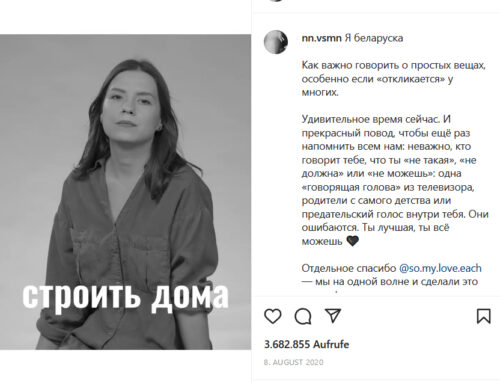In the animated clip A Soldier at 14, UNICEF tells the true story of a kidnapped child soldier who finally managed to escape an armed group in Southern Sudan.
How do children become soldiers, and what do they have to endure in captivity? Despite worldwide bans, tens of thousands of boys and girls are still being recruited by armed forces and armed groups in conflict-ridden regions and trained as child soldiers, scouts, and messengers – the girls also serve as sex slaves for the soldiers. On the occasion of the annual Red Hand Day on 12 February, the world day against the use of child soldiers, UNICEF released the animadoc A Soldier at 14 on YouTube. The children’s aid organisation also distributed the video via Facebook, Instagram, Twitter, and its own website. It was produced in cooperation with the South African advertising agency Rooftop. For fifteen years, the agency has been producing media content with a focus on human rights and social issues with a view to a peaceful and sustainable future. Rooftop works with NGOs such as UNICEF, foundations, and multilateral organisations and develops ‘stories that matter’.
In order to draw attention to the fate of child soldiers in Southern Sudan, but also in other countries, the organisation gives former child soldiers the opportunity to speak out, and they themselves are to bear witness to what happened to them. James, then 14 years old, is one of them: He becomes the anchor figure and narrator of A Soldier at 14. He tells of how armed fighters abducted him and raided his village. Only after he was shot in combat, badly wounded, and left to die could he be saved.
Building on the popular success of Waltz with Bashir (Ari Folman, 2008) about the traumatisation of an Israeli soldier, UNICEF has chosen comic-style animations to give the offscreen narrator James visual presence. This hybrid form of animadoc is largely a response to the lack of documentary footage, but the strength of this documentary genre is also that the subjective, intimate narrative and the illustration through images create a special closeness to the central character. It is James’s voice, it is his perspective, and it is his emotions that guide us: with the help of his voice-over commentary we are led through the images. The narrative is not limited to James’s perspective, however, since it provides an effective contrast through the parallel perspective of the mother mourning her child, who was believed to be dead.
The two perspectives intertwine on the visual and audio levels: the young narrator describes how, as a child soldier, he was forced to turn the guns on his own people under threat of violence, while his mother gives a touching account of her loss and her hope for the return of her son. The mother’s stories let the viewer empathise with the events and emotions of a mother who has been kept in the dark for years about her son’s condition. With this video UNICEF appeals to humanity and offers a form of empathy across all cultural boundaries. Basically, it is about emotions that are universally understandable – the grief over the disappearance of one’s own child. This is what makes the film so intimate, personal, and emotional for the viewer. With sentences like ‘It was so hard, not knowing where he was’ and ‘We had a funeral, without a body to bury’, UNICEF aims to create an emotional bond with the viewer. That UNICEF’s strategy works and that the mother’s perspective has an affective effect on viewers is shown by a Facebook user who, as a parent, empathises with the mother’s emotional world: ‘I can’t even imagine if that was my son. (Strong woman and hope all kids to be safe wherever they are.’
In general, the narrative corresponds to classic linear storytelling: the main character with whom one sympathises, 13-year-old James, the family’s breadwinner, has to leave his home country due to a drastic event. This is a reversal of the hero’s journey, a dark, inverted initiation story. Although James returns home after three years, he bears the wounds of the war – mentally and physically. His experiences have literally inscribed themselves on his body. He is injured, walks on crutches, a war homecomer, a bowed man.
His narrative is formally framed by the events in his homeland. Life before and after recruitment is contrasted visually. The film works with lighter colours during flashbacks from home, making the scenery appear light, weightless, and lively. The sequence presenting his memories begins with James’s recruitment at the river. The water is symbolic of his past and lost childhood, but at the same time it also represents the hope for a happy future. The river plays a special role as an elixir of life, emphasising James’s importance for his family. The boy, who is supposed to grow up to be the breadwinner of his family, becomes a child soldier and murderer. The memory of childhood, as a country he is violently forced to leave, is shown with bright colours, atmospheric music, and children’s laughter.
The symbol of water is juxtaposed with those of death and menace. Light colours are followed by a dark world that deprives the viewer of any pleasant feeling: a crow cries out, threatening music sets in. The appearance of a military vehicle at the lake means the end of James’s childhood – from now on he learns to kill.
Not only dark and subdued colours, but also the camera perspective points to the impending threat of death. When James is shot and left for dead, the camera captures this from a bird’s eye view, in a top shot of the dying boy on the ground. On the one hand, this view from above makes James seem helpless and unimportant, almost like an insect in a meadow. On the other hand, a cinematic convention takes effect here, which stands for approaching death and the soul leaving the body.
For the war memories, the film chooses extreme forms of framing – either through light and shadow, trees and the forest in long shots, fire, or soldiers taking James into custody from left and right. Each of these shot setups makes James seem lost and helpless. Sounds such as pistol shots, helicopter propellers, the flickering of the fire, or human screams intensify the oppressive atmosphere on the audio level.
With the help of a subjective camera, the viewer takes on James’s view as he is forced to fight against his own people. The point-of-view encourages the viewer to live through James’s war experience. How difficult it is for the boy to shoot at people and even kill them is illustrated by the black screen, which stands for closing his eyes when firing the rifle.
A Soldier at 14 tells an allegorical story of war, in which UNICEF inscribes itself as the saviour. With pictorial textual references, the film points out that James owes the reunion with his family to the aid organisation. The colour blue, symbol of hope, runs through the film as a repeated motif. Hope is not only in the water, but also in the UNICEF logo on the jeep that takes James back to his village. The blue, which is characteristic of UNICEF, is also taken up in the explanatory text panels and in James’s blue rucksack on a photograph of him, with which the story is, as it were, authenticated at the end.
Just like Waltz with Bashir, the film works with a change in the mode of representation and from then on uses photographic shots. With James’s return to his homeland, fiction turns into documentation: the victim James gets a face and a concrete embodiment. The comic characters become real people, the ‘true story’ is authenticated and at the same time becomes a model for many stories of recruited children. The insert, ‘This is a true story’, initiates this change of reality status. At the same time, this is associated with a strong emotional shift: the hope that the horrible story might be mere fiction must be abandoned for good. These things happen here, in our world, and we are responsible for doing something about them.
UNICEF’s primary goal is to arouse sympathy for the fate of child soldiers. Donations are therefore not explicitly requested. A Soldier at 14 plays cleverly with the audience, convincing them with a visually and audibly appealing narration. In the advertising agency Rooftop, UNICEF has engaged specialists in the field of immersive storytelling. The film is based on human experience: James and his mother embrace when they meet again. It appeals to basic human emotions, as the advertising agency emphasises on its website: ‘We realised we had everything we needed to connect with audiences. Because we all understand hope, love, and family.’ James’s tale of woe therefore has a high affective power, which is strategically used here – ‘a story that matters.’ The many comments in social networks prove that this strategy works: ‘Heart touching story’, ‘I am deeply touched.”
Kathleen Melanie Jung



